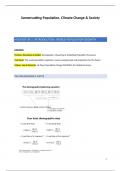Samenvatting Population, Climate Change & Society
HOOFDSTUK 1: INTRODUCTION; WORLD POPULATION GROWTH
Literature:
Preston, Heuveline & Guillot. Demography. Measuring & Modelling Population Processes
Van Bavel. The world population explosion: causes, backgrounds and projections for the future
Mason, Lee & Network. Six Ways Population Change Will Affect the Global Economy
THE DEMOGRAPHIC RATES
1
, Crude Growth Rate (CGR):
N (T )−N (0) B [ 0 ,T ] D [ 0 ,T ] I [ 0 ,T ] O [ 0 ,T ]
CGR [ 0 , T ]= = − + −
PY [ 0 ,T ] PY [ 0 , T ] PY [ 0 , T ] PY [ 0 ,T ] PY [ 0 ,T ]
¿ CBR [ 0 , T ] −CDR [ 0 ,T ] +CRIM [ 0 , T ]−CROM [ 0 ,T ]
These rates are crude, usually expressed pro mille (1/1000)
Crude rate of natural increase + of net migration
Constant basic rates constant growth rate exponential population growth
because it is expressed in relative terms !!
From this follows a fundamental first insight from the demographic theory of “stable
populations” namely: stable demographic behaviour and stable growth rates (e.g.
fertility and mortality) leads to an exponential growth in population size (cf. Malthus)
! Stable population ≠ Stationary population
Stable: rates are stable (constant)
Stationary: growth rate = zero
= special case of stable population
= equivalent of “life table population” (but that is for later)
INSTANTANEOUS AND AVERAGE GROWTH RATE, AND DOUBLING TIME
Instantaneous growth rate = average growth rate:
N (T ) N (T )
ln ln
N (0) N (0)
r0, T
*
r =
T T
Doubling time
‒ If the population doubles in T years’ time,
N (T )
N (T ) ln ln( 2) 0.693
=2 N (0)
N (0)
2
, ‒ Based on this number and the growth rate equation we can calculate doubling time
0.693
T=
r
1.099
‒ or the tripling time T =
r
2.303
‒ or the quadrupling time T =
r
Conclusion: long term population growth is only sustainable if it remains close to 0
Thomas R. Malthus came to this conclusion is his Essay on the Principle of Population
(1798)
• At some point, population growth must be halted
‒ either through increased mortality
‒ either through decreased fertility
‒ locally: migration
• What he was seeing in his days was worrying him…
POPULATION EXPLOSION ACROSS SPACE AND TIME
1750-1950: Europe + North-America + Oceania
‒ Gradual acceleration of growth
‒ Relatively small scale
1950-today: Asia + Africa + Latin-America
3
, ‒ Fast acceleration of growth
‒ Large scale
Now:
Stabilisation and slowing down of population growth in western countries
Rapid growth of population growth and no sign of slowing down in Asia, Africa and
Latin-America
THE DEMOGRAPHIC TRANSITION
Demographic transition: an extensive and long-lasting imbalance between birth and death
rates that leads to a persistently larger or smaller population
A demographic transition is always temporary, because if the imbalance (of fertility and
mortality) is permanent, growth will be exceeding any imaginable limit (as population growth
happens exponentially)
1) Neolithic agricultural revolution
Sustainable growth of the population is only possible through increases in the production
capacity through extensification: decreasing input of capital and inputs (e.g. fertilizers,
pesticides, machinery) and intensification: increasing input of agricultural resources (e.g.
seeds, labour, knowledge, technology)
Social innovation (+- 9000 BC): hunter-gatherers farmers
Reproductive culture:
o better nutrition = higher fertility
o labour intensive economy = many children desirable
o no mobility problem
But:
o higher density = spreading of diseases, war
o vulnerable for failed harvests
mortality crisis
4




